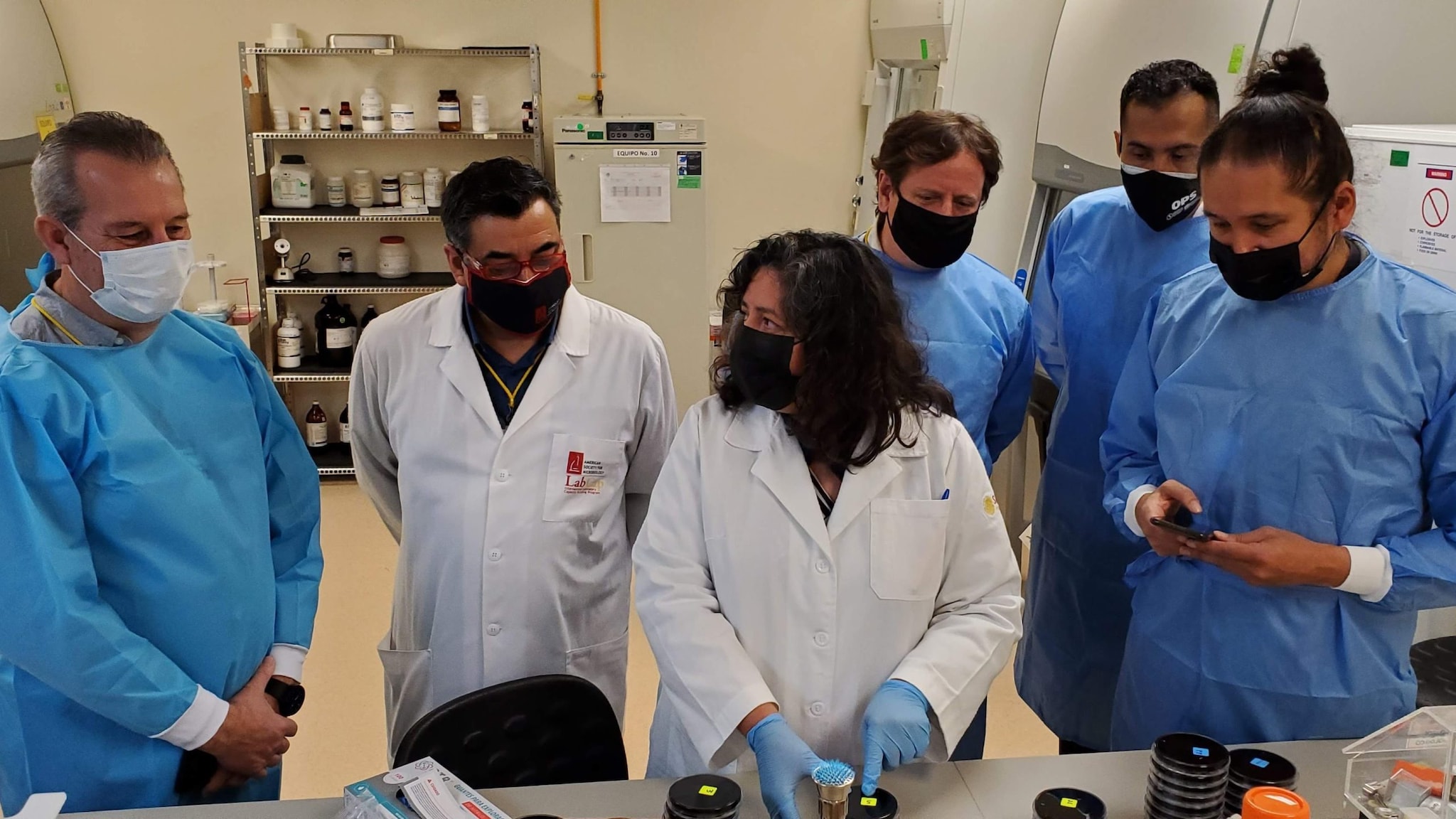At a glance
CDC collaborates with health officials in Mexico to address infectious diseases, enhance surveillance, and respond to outbreaks. The CDC Mexico Country Office coordinates the Binational Technical Working Group and collaborates closely with the Mexico Ministry of Health, focusing on a wide-range of public health priorities, to improve U.S.-Mexico public health. These include initiatives related to tuberculosis, laboratory capacity, antimicrobial resistance, influenza surveillance, and migrant health.

About the CDC Mexico Country Office
CDC collaborates with Mexico health officials to prevent the spread of disease among binational communities and mobile populations that travel between both countries. The CDC Mexico Country Office (CDC Mexico) was established in 2000 as part of CDC Division of Global Migration Health (DGMH) Southern Border Health and Migration Branch (SBHMB).
As new health challenges emerge, CDC Mexico provides technical support for
- Investigating and controlling binational and international infectious disease outbreaks
- Enhancing binational surveillance, laboratory capacity, and illness response
- Communicating with U.S. and foreign government officials on policies critical to binational health
CDC's Impact in Mexico
COVID-19
CDC supported the Mexican Secretariat of Health with $3.168 million through a cooperative agreement with the U.S.-Mexico Foundation for Science in 2020 to 2022. Funds were used to conduct the first nationally representative COVID-19 serosurvey (study that measures proportion of persons in a community that have antibodies to a given germ), epidemiological surveillance, risk communication, and population mobility analysis in and throughout Mexico.
Note:
Binational Technical Working Group (BTWG)
The BTWG was established in 2012 to address mutual public health concerns because of the inter-connectedness of people who cross the U.S.-Mexico border or live in the border regionA.
The BTWG assesses and advises on binational public health issues and assists with developing binational public health initiatives or policies for the two countries. This work is possible by collaborating with public health officials from the U.S. and Mexico border states, CDC, and Mexico's Directorate of Epidemiology and the National Center for Preventive Programs and Disease Control.
Led by CDC Mexico, the group of subject matter experts meets each month to exchange information about infectious diseases in the border region, research initiatives, epidemiologic trends, and tools that can be implemented binationally.
Recent BTWG meeting topics included
Disease Surveillance
CDC Mexico collaborates with the Binational Border Infectious Disease Surveillance (BIDS) program to improve binational disease prevention.
BIDS officers in U.S. border states work with partners in Mexican sister-cities and states to share disease information and collaborate on binational outbreaks. For example, the California BIDS program was instrumental in exchanging information with Baja California on a group of a rare antibiotic resistant infections associated with surgery conducted at a healthcare facility in Tijuana, Baja California, Mexico.
CDC Mexico also supported a pilot of an antimicrobial resistance surveillance system and standardized treatment guidance for primary care settings in Mexico. Additionally, CDC Mexico supported Mexico in creating a national vaccine registry.
Note:
Tuberculosis (TB)
TB remains a leading cause of infectious disease deaths worldwide. CDC Mexico provides technical support to fight TB in Mexico and works with the CureTB program to ensure mobile populations get treatment or preventive care for TB. CDC Mexico supports the National Action Program for the Prevention and Control of Tuberculosis by studying the use of TB blood tests (also called interferon-gamma release assays or IGRAs) to diagnose latent TB infection in people with high-risk for developing TB (e.g., those with HIV, diabetes mellitus, and children under 5 years of age) and have had close contact with someone with infectious TB.
Note:
Laboratory
CDC has several international laboratory projects in Mexico, including two in Sonora and Baja California. These projects aim to enhance disease control programs’ capacity to identify groups of people at risk for developing drug-sensitive TB (DS TB) or drug-resistant TB (DR TB) that would most benefit from a rapid molecular TB test. The goal is to detect DS TB and DR TB in the highest number of people using the least resources. As part of the effort in Sonora, CDC is also studying rapid molecular testing of new types of samples for TB testing in children under 10 years of age. The stool and nasopharyngeal aspirate (suction from the back of the nose) samples are easier and faster to collect than standard samples and may reduce the need for hospitalization.
CDC global and domestic teams collaborated to enhance the national electronic surveillance system in Mexico, known as Plataforma. The update allows a more accurate reporting of DR TB cases.

Influenza
CDC and the Mexico Health Secretariat have a decades-long influenza surveillance collaboration. The year-round surveillance allows for early detection and identification of seasonal influenza viruses and new influenza A viruses that may be able to cause a pandemic. The collaboration is also using new technology to improve existing reporting tools.
Note:
Migrant Health
Mexican-born people are the largest immigrant group living in the United States.
Note:
CDC Mexico collaborates with multiple partners to enhance the availability of public health surveillance for Mexican-origin populations in the United States and to assess health disparities.
CDC Mexico also works with partners to describe infectious disease risks, barriers in access to health care, and preventive services for migrant populations transiting through and within Mexico. The aim is to provide local, regional, and national public health officials timely and accurate data to inform health strategies.
- The U.S.-Mexico border region is made up of 44 counties across four U.S. states and 80 border municipios across six Mexican states within 100 km (62 miles) of the 2000-mile-long international border line.
